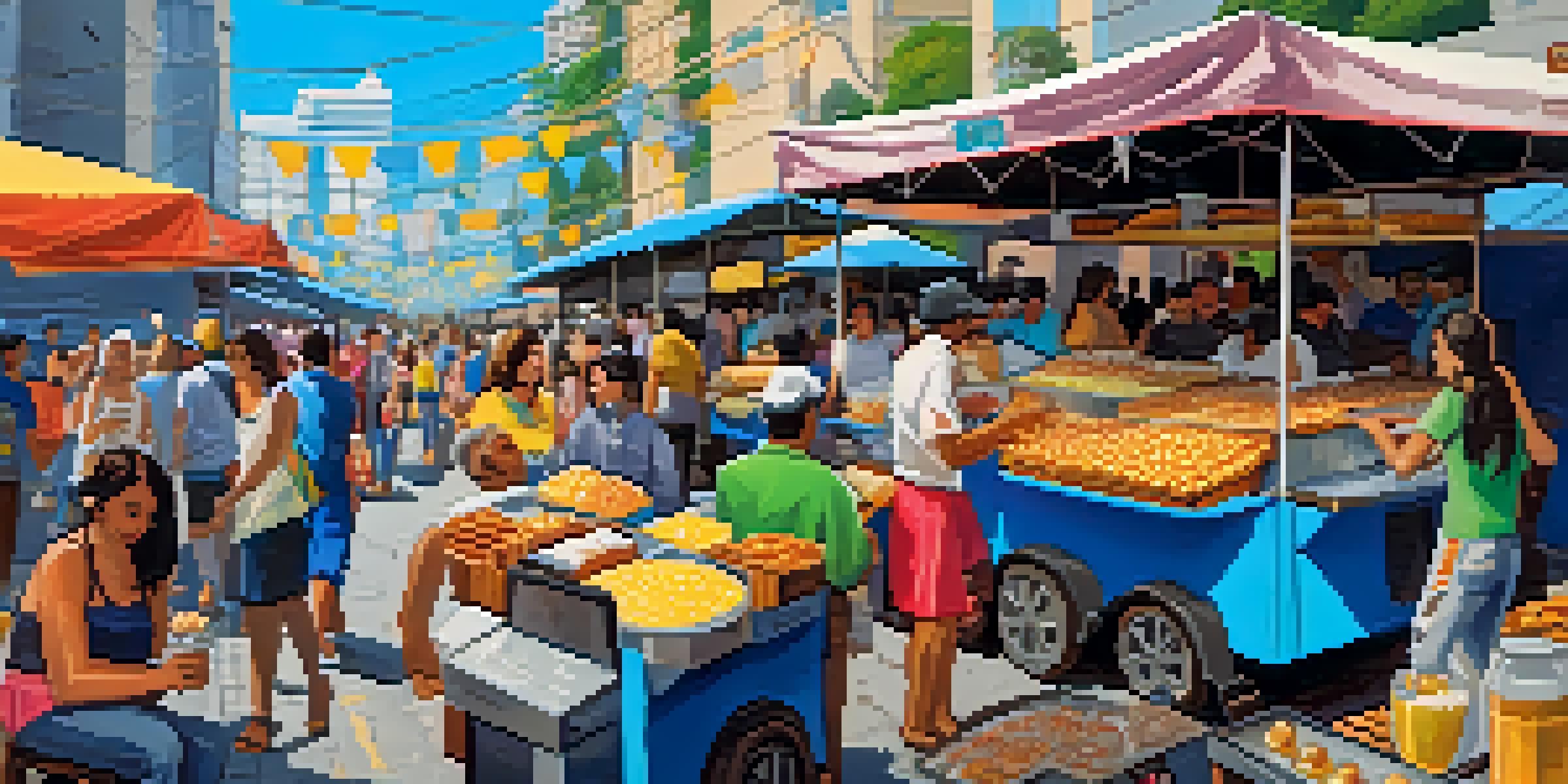Brazil's Regional Dishes: A Culinary Heritage Exploration

Introduction to Brazil's Culinary Landscape
Brazil's culinary landscape is as diverse as its geography, with each region offering unique flavors and traditional dishes. From the Amazon rainforest to the Atlantic coast, these regional specialties reflect the history and culture of their respective areas. Understanding Brazilian cuisine means exploring the fusion of indigenous, African, and European influences that have shaped it over centuries.
Food is our common ground, a universal experience.
This culinary exploration is more than just food; it’s a deep dive into Brazil's cultural heritage. Each dish tells a story, often tied to the land and the people who inhabit it. As we journey through Brazil’s regions, we'll uncover the ingredients and cooking techniques that make each dish a unique experience.
In this article, we will highlight some of the most iconic regional dishes, showcasing not only their flavors but also the traditions behind them. Get ready to embark on a delicious adventure through Brazil's rich culinary heritage!
Northeast Brazil: A Symphony of Spices
The Northeast region of Brazil is famous for its vibrant flavors, heavily influenced by indigenous and African cooking traditions. Dishes like acarajé, a deep-fried ball of black-eyed pea dough filled with shrimp, exemplify the bold spices and ingredients used in this region. This dish is often served at street fairs, showcasing the communal spirit of Brazilian cuisine.

Another staple is moqueca, a fragrant fish stew made with coconut milk, dendê oil, and a variety of spices. Each family has its own twist on this dish, making it a symbol of regional pride. The use of local ingredients like palm oil and fresh seafood highlights the region's coastal geography.
Diverse Flavors Across Brazil
Brazil's regional cuisines reflect a rich fusion of indigenous, African, and European influences, offering unique dishes tied to local culture and geography.
Northeast Brazil's food is more than just sustenance; it's a celebration of life, often accompanied by music and dance. Festivals celebrating local dishes create a sense of community, where flavors and traditions are passed down through generations.
Southeast Brazil: A Blend of Tradition and Modernity
Southeast Brazil, home to bustling cities like São Paulo and Rio de Janeiro, presents a blend of traditional and modern culinary influences. Here, you'll find iconic dishes like feijoada, a hearty black bean stew with pork that is often considered the national dish. Feijoada is typically served on Wednesdays and Saturdays, accompanied by rice, collard greens, and orange slices.
The discovery of a new dish does more for human happiness than the discovery of a star.
Street food plays a crucial role in the Southeast's culinary scene, with treats like pastel (fried pastry) and coxinha (chicken croquette) being popular among locals and tourists alike. These snacks are not just quick bites; they encapsulate the region's rich culinary history and the influence of immigrant communities.
As the region continues to evolve, chefs are experimenting by incorporating international flavors while respecting traditional techniques. This fusion creates a dynamic food scene where old meets new, making Southeast Brazil a fascinating destination for food lovers.
South Brazil: A Taste of the Pampas
The southern region of Brazil is known for its rich agricultural land and the strong influence of gaucho culture, resulting in hearty, meat-centric dishes. Churrasco, or Brazilian barbecue, is a celebrated tradition here, where various cuts of meat are grilled over open flames and served with chimichurri sauce. This communal dining experience embodies the spirit of friendship and hospitality.
Another notable dish is barreado, a slow-cooked beef stew that is typically served with rice and banana. This dish has its roots in the state of Paraná and reflects the region's indigenous and Portuguese heritage. The cooking method, which involves sealing the pot with banana leaves, allows the flavors to meld beautifully.
Street Food as Cultural Experience
Street food in Brazil serves not only as a quick meal but also as a vibrant reflection of the country's traditions and communal spirit.
In South Brazil, food is not just about taste; it is about gathering people together. Whether it's a family barbecue or a festive gathering, the emphasis on sharing and enjoying meals together is a hallmark of this region's culinary identity.
Central Brazil: The Heart of the Country's Cuisine
Central Brazil, often referred to as the heart of the country, features a culinary style that is simple yet flavorful, drawing heavily from local ingredients. Dishes like pequi rice, made with the unique pequi fruit, showcase the region's agricultural bounty. This fruit has a strong taste that many locals adore, making it a staple in traditional meals.
Another dish that highlights Central Brazil's culinary heritage is galinhada, a chicken and rice dish that is seasoned with saffron and often served during family gatherings. This dish reflects the region's emphasis on home-cooked meals and the importance of family ties.
The culinary traditions in Central Brazil emphasize sustainability and local sourcing, with many families growing their own ingredients. This connection to the land fosters a deep appreciation for the natural resources that contribute to their meals.
Amazon Region: A Treasure Trove of Exotic Ingredients
The Amazon region of Brazil is like no other when it comes to its culinary offerings, featuring an array of exotic ingredients found nowhere else. Dishes often incorporate fruits like açaí and cupuaçu, which are not only delicious but also packed with nutrients. Açaí bowls have gained worldwide popularity, but their roots trace back to the indigenous cultures of the Amazon.
Fish like tambaqui and pirarucu are also staples in the local diet, often prepared in traditional ways that honor the indigenous peoples' customs. The use of fresh herbs and spices enhances the flavors, creating dishes that are vibrant and aromatic.
Celebrating Culinary Heritage
Each regional dish in Brazil tells a story, connecting people to their history and fostering community through shared culinary experiences.
Exploring Amazonian cuisine is a unique experience that highlights the importance of biodiversity and sustainable practices. Chefs in this region are increasingly focused on preserving traditional methods while promoting the use of indigenous ingredients in their cooking.
The Role of Street Food in Brazilian Culture
Street food in Brazil is not just a quick meal; it is a cultural experience that reflects the country’s vibrant spirit. From the bustling markets of São Paulo to the beachside stalls in Rio de Janeiro, street vendors offer a variety of delicious and affordable options. Popular choices include pão de queijo, a cheesy bread roll, and brigadeiro, a sweet chocolate truffle.
These street foods often tell a story, linking back to regional ingredients and traditions. For instance, the popularity of tapioca pancakes in the Northeast showcases the use of cassava, a staple ingredient in Brazilian cuisine. This connection to local ingredients enriches the street food experience.

Street food also fosters a sense of community, as locals gather around food stalls, sharing stories and enjoying meals together. It’s a testament to the Brazilian way of life, where food is not only nourishment but also a way to connect with others.
Conclusion: Celebrating Brazil's Culinary Diversity
Brazil's culinary heritage is a rich tapestry woven with diverse regional influences, each contributing to the country's unique identity. From the spicy dishes of the Northeast to the hearty meals of the South, every region offers something special for food enthusiasts to explore. This variety not only tantalizes the taste buds but also provides a window into Brazil's history and culture.
As we celebrate these regional dishes, we also embrace the stories behind them—the families, traditions, and rituals that keep these culinary practices alive. Understanding the significance of these foods allows us to appreciate the value of community and shared experiences in Brazilian culture.
In a world that often feels disconnected, the act of gathering around a meal can bridge gaps and foster connections. So, whether you're indulging in a bowl of feijoada or savoring a street-side acarajé, remember that you're part of a larger story—one that celebrates the rich and diverse culinary heritage of Brazil.